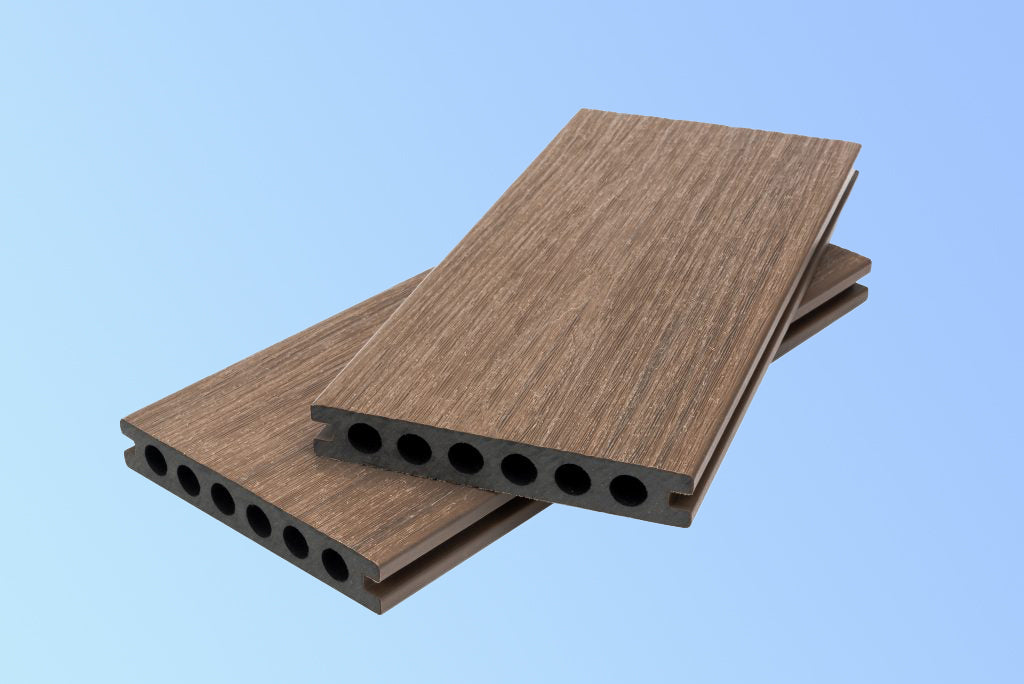0115 684 8754

Debunking 9 myths and misconceptions about composite decking
Thinking about upgrading your outdoor space with a deck, but hesitant due to the myths surrounding composite decking? You're not alone. Many people are often misinformed about the qualities and benefits of composite decking. Let's clear the air and debunk some of the common misconceptions surrounding this innovative decking solution.
Myth #1: Composite decking is expensive
One of the most common myths about composite decking is its perceived high cost. While it's true that the initial investment may be slightly higher than traditional wood decking, composite decking offers significant long-term savings. Its durability and low maintenance requirements mean you'll spend less on repairs, staining, and sealing over the lifespan of your deck. Additionally, composite decking's longer lifespan means you won’t need to replace it for years, or maybe ever! For the best value for money, we recommend buying a capped composite board, which comes with additional protection. Try our Premium and Supreme ranges.

Myth #2: Composite decking is slippery
Concerns about slipperiness often deter people from choosing composite decking, especially in wet conditions. However, modern composite decking solutions are designed with slip-resistant surfaces to provide a safe outdoor environment for your family and guests. Some products, like our reversible Core range, even feature textured finishes that enhance traction, making them ideal for areas prone to moisture or high foot traffic. With proper installation and maintenance, slipping on composite decking is no more of a concern than with traditional wood decks.

Myth #3: Composite decking warps over time
Another misconception is that composite decking warps or bends over time, compromising its structural integrity. While early iterations of composite decking may have been susceptible to warping, advancements in manufacturing processes have addressed this issue. Today's composite decking products are engineered to withstand fluctuations in temperature and humidity, ensuring they remain straight and sturdy for years. It’s important to follow our installation guide when installing your decking, to ensure you give your boards sufficient room to expand and contract with changing temperatures. This will prevent warping.

Myth #4: Composite decking fades quickly
Some homeowners worry that composite decking will lose its vibrant color and fade under prolonged exposure to sunlight. However, many composite decking boards - including ours - now come with UV protection as standard, which provides significant protection against fading. That being said, you should still expect minimal fading over long periods of time, because nothing is immune to weathering effects. You can read more about this in our blog about fading. If you invest in a polymer capped board, like our Premium and Supreme ranges, you will enjoy extra protection against long-term fading. Importantly, composite decking has significantly more in-built protection against fading than wood alternatives, so it maintains its appearance for much longer.

Myth #5: Composite decking has an unnatural, plastic finish that looks tacky
Composite decking is made from WPC, which stands for wood plastic composite. Because it contains plastic, some people believe that it has a “plasticky” finish that makes it look cheap and tacky. However, modern decking boards like ours are carefully and artistically crafted to very closely mimic the appearance of natural timber, and look extremely classy and elegant once installed. If you’re after something extra authentic, try our Rustic range, which has all the charm of beautifully aged timber.

Myth #6: Composite decking gets too hot in the sun
While it's true that any outdoor surface can become warm to the touch under direct sunlight, composite decking is not inherently more heat-absorbent than traditional wood. In fact, many composite decking products feature heat-resistant properties that help mitigate temperature fluctuations. Additionally, choosing lighter-colored composite decking - such as our Light Grey, Antique and Stone shades - or incorporating shade structures, can further reduce surface temperatures, ensuring your deck remains comfortable even on those rare hot summer days.

Myth #7: The expansion and contraction of composite is a problem
Some homeowners worry that the natural expansion and contraction of composite materials in response to temperature changes may lead to structural issues with their deck. It’s true that composite boards, like any solid material, expand in the heat and contract in the cold, but this doesn't have to be a problem. The main thing to keep in mind is that, because of the way they're manufactured, composite decking boards only tend to expand and contract lengthwise, so it's very important to maintain a 4-6mm gap between boards that are placed end-to-end. You can find guidelines on this and other important information in our installation guide. As long as you follow this guide, you don't need to worry about expansion and contraction - you can just enjoy your deck!

Myth #8: Composite decking is not eco-friendly
Contrary to popular belief, composite decking can be an environmentally friendly choice for outdoor projects. All of our decking ranges are made out of recycled waste plastic and wood that would otherwise have ended up in landfill sites and oceans. Additionally, composite decking's long lifespan and low maintenance requirements contribute to its eco-friendliness by reducing the need for frequent replacements and chemical treatments associated with traditional wood decking. You can read more about the environmental impact of our composite decking here.

Myth #9: Composite decking requires excessive maintenance
One of the key advantages of composite decking is its minimal maintenance requirements compared to traditional wood decking. Unlike wood, composite decking does not require staining, sealing, or painting to maintain its appearance and performance. A simple routine cleaning with soap and water is typically all that's needed to keep your composite deck looking fresh and vibrant. Additionally, composite decking is resistant to rot, decay, and insect damage, eliminating the need for costly and time-consuming repairs. With minimal upkeep, you can enjoy a beautiful, hassle-free outdoor living space year-round, allowing you to spend more time relaxing and less time maintaining your deck.

Conclusion
In conclusion, composite decking offers a versatile, durable, eco-friendly and low-maintenance alternative to traditional wood decking. By dispelling these myths and misconceptions, we hope to empower homeowners to make informed decisions when it comes to enhancing their outdoor living spaces. If you're considering composite decking for your next project, rest assured that it's a worthy investment that will provide years of enjoyment and beauty with minimal upkeep required.
For more information on composite decking facts and benefits, browse our website or contact our team of experts, or view our full range of composite decking products today. We're here to help you transform your outdoor oasis with the best composite decking solutions tailored to your needs and preferences.


